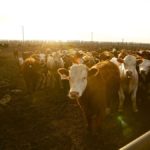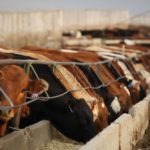Compared to last week, western Canadian yearling prices were down $3-`$5 on average while calves were unchanged to down $2. Sales were characterized by low volumes and limited buying interest. Feedlot operators are hesitant to step forward in the current environment, with packing plants on both sides of the border reducing capacity. At the same […] Read more
Tag Archives Feedlot — page 11

Klassen: Uncertainty defines feeder market
'Hope' factor remains supportive

Klassen: Weaker fed cattle prices weigh on feeder market
It appears finishing feedlots and cattle buyers are coming to terms with the fact that the COVID-19 pandemic may last longer than earlier anticipated. The “hope” factor that this environment will be short-lived has evaporated. Compared to last week, western Canadian feeder cattle markets traded $3 to as much as $10 lower, with yearlings absorbing […] Read more

Klassen: Feeder market lacks buying interest
Market gives in to pressure from Chicago futures
Compared to last week, western Canadian feeder cattle markets traded $5-$8 lower on average, with yearlings dropping as much as $10-$12 in certain areas. It appears buyers are incorporating a risk discount due to uncertainty in beef demand longer-term. Rising unemployment levels, sluggish consumer confidence and a sharp drop in disposable income are all factors […] Read more

U.S. livestock: Hog futures hit 17-1/2-year low
Cattle also sink as virus measures disrupt markets
Chicago | Reuters — U.S. hog futures fell on Friday to the lowest point since late 2002 on tumbling pork prices and slowing slaughter rates as measures to control the COVID-19 coronavirus pandemic shuttered schools and restaurants and sent U.S. unemployment rates soaring. Cattle futures also dropped as wholesale beef and cash feedlot cattle prices […] Read more

Take extra steps to keep farm workers safe during COVID-19
Add biosecurity practices, or ramp up the ones you already employ
Farmers concerned about the spread of COVID-19 can learn from the hog sector on the matter of protecting themselves and their workers, says a leading expert on biosecurity in the pork industry. “This is the world of biosecurity that the swine industry deals with on a daily basis,” said Dr. Egan Brockhoff, veterinarian counsellor for […] Read more

Klassen: Feeder market digesting lower beef demand
Compared to last week, western Canadian yearling prices were down $12-$18; mid-weight calves were down $10 to as much as $15 while calves under 550 lbs. were down $4-$8. The market is incorporating a risk discount due to uncertainty in beef demand for the second and third quarters of 2020. Feedlot margins are in negative […] Read more

Klassen: Extreme variability characterizes feeder market
Western Canadian feeder cattle prices were extremely variable over the past week which made the market hard to define. Compared to last week, yearling prices were quoted $2 to as much $6 lower while calves traded $2 lower as much as $5 higher. While some auction crowds were caught up with the negative news coverage, […] Read more

Klassen: Calves remain firm while yearlings falter
Compared to last week, western Canadian yearling markets traded $3-$5 lower while calves and grassers traded within $5 on either side of unchanged. Calves were extremely variable with similar weight cattle sometimes trading $6-$8 apart at the same sale. Supplies of calves coming on the market appear to be lower than last year. This may […] Read more

Klassen: Calf prices divorce from yearling markets
Compared to last week, yearling prices were steady to as much as $4 lower depending on the region in Western Canada. Alberta packers were buying fed cattle at an average price of $252 on a dressed basis, down $6-$8 from last week and down about $20 from the last week of January. Weakness in fed […] Read more

Feed weekly outlook: Buyers not looking to make purchases
MarketsFarm — Feed grain prices were beginning to soften as many buyers don’t have a major need to purchase from growers, said Nelson Neumann, senior trader for Agfinity in Stony Plain, Alta. “There’s still obviously a demand, but buyers are pretty well covered for the February-March timeframe. That’s a window where a lot of growers […] Read more


